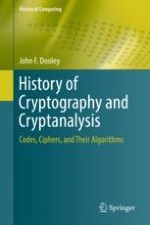2018 | OriginalPaper | Buchkapitel
6. Crypto and the War to End All Wars: 1914–1919
verfasst von : John F. Dooley
Erschienen in: History of Cryptography and Cryptanalysis
Aktivieren Sie unsere intelligente Suche, um passende Fachinhalte oder Patente zu finden.
Wählen Sie Textabschnitte aus um mit Künstlicher Intelligenz passenden Patente zu finden. powered by
Markieren Sie Textabschnitte, um KI-gestützt weitere passende Inhalte zu finden. powered by
